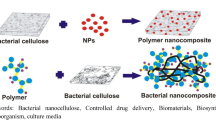Highly effective means of stopping capillary-parenchymatous bleeding — one of the main causes of death in people from 1 to 34 years of age in traffic accidents — were developed. Biologically active wound dressings that reduce purulent-necrotic wound cleansing time by 3 times, healing time by 2.5 times, and hospital stays by 6 times were developed.
Similar content being viewed by others
References
L. Morgenstern, Surg. Gynecol. Obstet., 145, 525-528 (1977).
K. J. Smith, H. G. Skelton, et al., J. Am. Acad. Dermatol., No. 34, 434-438 (1996).
V. T. Apoyan, Experim. Klin. Med., No. 3, 306-309 (1987).
D. Coln, J. Horton, et al., Am. J. Surg., No. 145, 256-259 (1983).
B. C. Adelmann-Grill and K. Otto, Arzneimittelforschung, No. 37, 802-805 (1987).
E. Solheim, E. M. Pinholt, et al., J. Biomed. Mater. Res., No. 26, 791-800 (1992).
Author information
Authors and Affiliations
Additional information
Translated from Khimicheskie Volokna, No. 1, pp. 31-33, January-February, 2009.
Rights and permissions
About this article
Cite this article
Medusheva, E.O., Filatov, V.N., Ryltsev, V.V. et al. Possibilities of molecular modeling of cellulose in fabrication of therapeutically active textile materials. Fibre Chem 41, 34–37 (2009). https://doi.org/10.1007/s10692-009-9115-0
Published:
Issue Date:
DOI: https://doi.org/10.1007/s10692-009-9115-0




